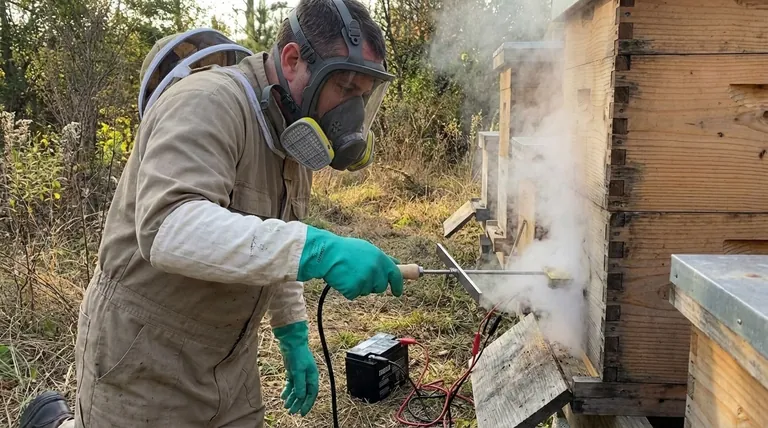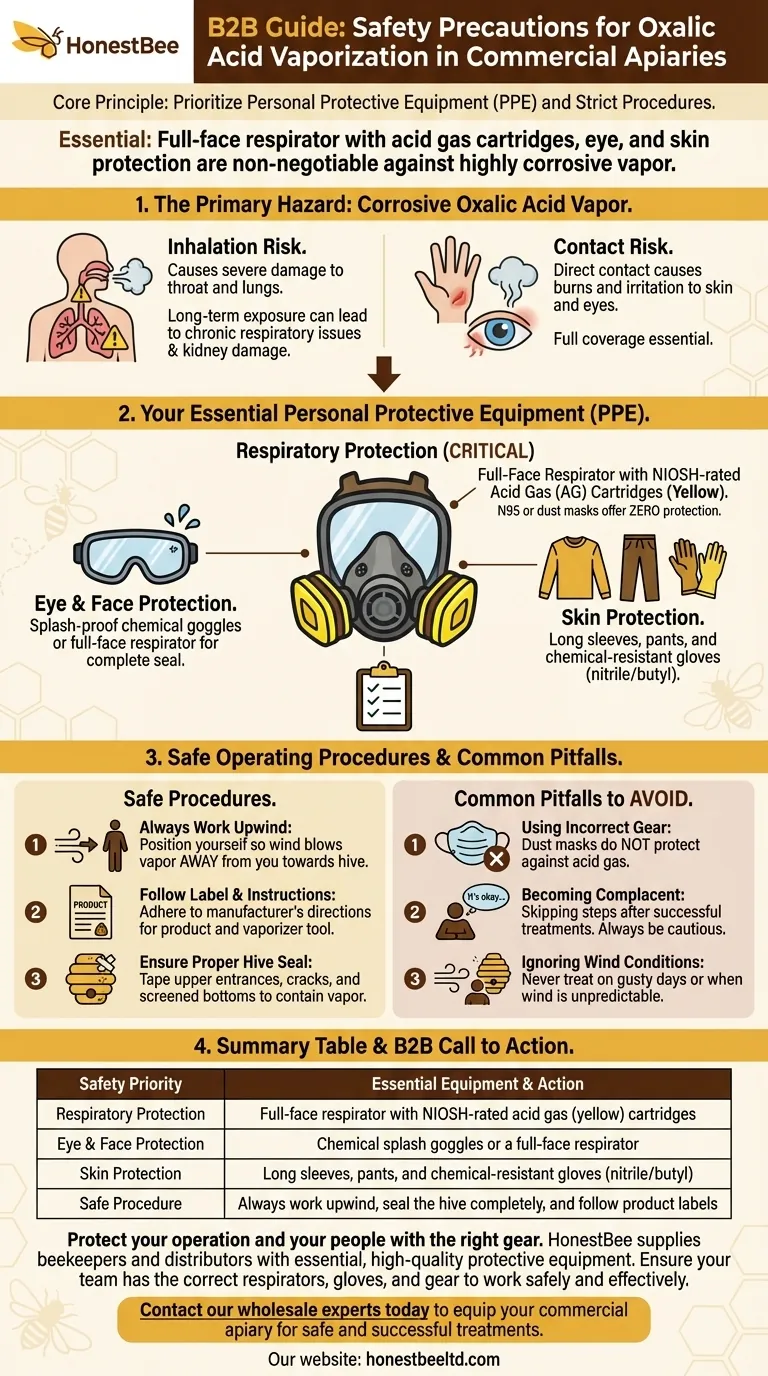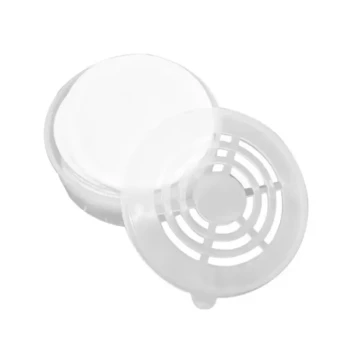At its core, safety during oxalic acid vaporization requires a full-face respirator rated for acid gas, along with eye and skin protection. This treatment is highly effective against varroa mites but poses a significant health risk if the vapor is inhaled or comes into contact with your body. Therefore, treating personal protective equipment (PPE) as non-negotiable is the first and most critical step.
While oxalic acid vaporization is an efficient and valuable tool for hive health, the vapor is highly corrosive and dangerous to humans. Your safety depends entirely on using the correct, specialized respiratory protection and following strict handling procedures every single time.

The Primary Hazard: Understanding Oxalic Acid Vapor
Oxalic acid is an organic compound that is safe for bees at the correct dosage but is toxic and corrosive to humans. When heated, it sublimates—turning from a solid crystal directly into a gas. This gas is the tool for mite treatment, but it is also the source of the danger.
The Risk of Inhalation
The primary danger is inhaling the vapor. Because it's an acid, it can cause severe, immediate damage to the sensitive tissues in your throat, lungs, and entire respiratory system.
Long-term or repeated exposure without proper protection can lead to chronic respiratory issues and potential kidney damage. The risk is not to be underestimated.
The Risk of Contact
Direct contact with oxalic acid crystals or the hot vapor can cause burns and irritation to the skin and eyes. This is why comprehensive gear that covers all exposed areas is essential.
Your Essential Personal Protective Equipment (PPE)
General-purpose gear is not sufficient. You must use equipment specifically designed to protect against acidic gases and chemicals.
Respiratory Protection is Non-Negotiable
A simple dust mask or an N95 mask is completely inadequate and offers no protection from acid gas. You must use a respirator with the correct cartridges.
Look for a half-mask or full-face respirator equipped with acid gas (AG) cartridges. These are often color-coded yellow by NIOSH standards. A P100 particulate filter is often combined with the AG cartridge, which is also beneficial.
Eye and Face Protection
Vapor can easily bypass standard safety glasses. You must use splash-proof chemical goggles that form a complete seal around your eyes.
For maximum protection, a full-face respirator is the best option, as it combines respiratory and eye protection into a single, sealed unit.
Skin Protection
To prevent burns and irritation, wear long sleeves and pants made of a durable material.
You must also wear chemical-resistant gloves, such as nitrile or butyl rubber, to protect your hands when handling the acid crystals and the vaporizer tool.
Safe Operating Procedures
Beyond wearing the right gear, your process is a key part of your safety.
Always Work Upwind
Position yourself so that the wind is blowing away from you and towards the hive entrance. This simple step ensures that any vapor that might escape the hive is carried away from you. Never treat a hive if you are downwind from it.
Read and Follow the Label
Always follow the manufacturer's instructions for both the oxalic acid product and the vaporizer tool. The label provides legally mandated directions for dosage, application, and specific safety warnings.
Ensure a Proper Hive Seal
Before you begin vaporization, seal any upper entrances, cracks, or screened bottom boards with tape or cloth. This not only increases the treatment's effectiveness by containing the vapor but also minimizes your risk of accidental exposure.
Understanding the Common Pitfalls
Even experienced beekeepers can make mistakes. Being aware of them is the best way to ensure your own safety.
Mistake: Using Incorrect Respiratory Gear
The most common and dangerous mistake is using a simple dust mask. These masks only filter particulates (like dust and pollen) and offer zero protection against acid gases, giving you a false sense of security while you inhale corrosive fumes.
Mistake: Becoming Complacent
After a few successful treatments, it's easy to become complacent and skip a step, like not sealing the hive properly or ignoring a slight shift in wind direction. Treat every application with the same high level of caution as the first.
Mistake: Ignoring Wind Conditions
A calm day is ideal for treatment. If the wind is gusty or unpredictable, postpone the treatment. A sudden change in wind direction can instantly envelop you in vapor, even if you started in an upwind position.
Making the Right Choice for Your Goal
Your approach to oxalic acid vaporization must prioritize your own health above all else. The goal is healthy bees, but that is impossible without a healthy beekeeper.
- If your primary focus is personal safety: Invest in a high-quality, full-face respirator with acid gas cartridges and never perform a treatment without it.
- If your primary focus is mite treatment effectiveness: Understand that proper safety procedures, like sealing the hive, directly improve treatment efficacy while also protecting you.
Protecting yourself is the most important prerequisite for protecting your hives.
Summary Table:
| Safety Priority | Essential Equipment & Action |
|---|---|
| Respiratory Protection | Full-face respirator with NIOSH-rated acid gas (yellow) cartridges |
| Eye & Face Protection | Chemical splash goggles or a full-face respirator |
| Skin Protection | Long sleeves, pants, and chemical-resistant gloves (nitrile/butyl) |
| Safe Procedure | Always work upwind, seal the hive completely, and follow product labels |
| Common Pitfall | Never use a dust mask or N95; they offer zero protection against acid vapor. |
Protect your operation and your people with the right gear. Oxalic acid vaporization is a powerful tool for commercial mite control, but its effectiveness depends on absolute safety. HONESTBEE supplies beekeepers and equipment distributors with the essential, high-quality protective equipment needed for this critical procedure. Ensure your team has the correct respirators, gloves, and gear to work safely and effectively. Contact our wholesale experts today to equip your commercial apiary for safe and successful treatments.
Visual Guide

Related Products
- Oxalic Acid Vaporizer 12V for Bee Varroa Mite Treatment
- 12V Bee Mite Removal Evaporator Oxalic Acid Vaporizer for Bee Fumigation Treatment 180W Atomization
- Compact Circular Bee Mite Treatment Dispenser
- HONESTBEE Advanced Ergonomic Stainless Steel Hive Tool for Beekeeping
- Long Langstroth Style Horizontal Top Bar Hive for Wholesale
People Also Ask
- Can oxalic acid vaporization be used with honey supers on the hive? Ensure Legal Compliance & Honey Safety
- How is the oxalic acid solution prepared for vaporization? No Solution Needed—Use Dry Crystals for Varroa Control
- What should be done after applying the vapor? A Step-by-Step Guide to Sealing Your Hive
- What is the most common method of applying oxalic acid for mite control? Dribble vs. Vaporization for Varroa
- What is the role of oxalic acid in plants? A Key to Plant Defense and Internal Regulation



















